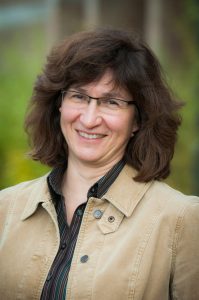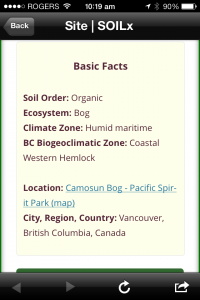When soil scientists at UBC, TRU, UNBC, U Saskatchewan and U of T-Mississauga wanted to engage a broader audience in contributing to and expanding knowledge about soil, they combined open source and mobile technologies, collaboration, and augmented reality to create SOILx.

SOILx – which stands for Searchable, Open, Innovative, Location-based, is an innovative project that provides rich, geo-located information about different soil study sites across Canada. The project was funded by BCcampus in 2012 through its Online Program Development Fund (OPDF) and features collaborative partnerships and resources that are licensed for re-use and redistribution, The OPDF was replaced by the Open Textbook Project in 2012.
SOILx is a practical tool built on mostly open source technologies with the end user in mind. The site is built on the popular WordPress publishing platform widely known for its aesthetics and usability.
To store and manage soil data, SOILx uses Google Fusion Tables. Data is open to the public and users can view and download data. Those who have ‘good quality data’ can submit it for review to the SOILx resource, using a simple online template.
Adding another layer of information, SOILx uses an open source augmented reality (AR) tool called Wikitude that supports Google maps, links to websites, images, and video, all designed to enhance the learning experience. The tool is optimized for mobile devices making it easy for users to get and interpret information in the field. SOILx users include post-secondary students and instructors, land use planners, gardeners, and anyone interested in soil.
“The goals of the SOILx project are to provide an aggregate of existing information and multimedia resources on soil sites used for education, and then bring this information to mobile devices for users in the field,” said Maja Krzic, Associate Professor, Faculty of Forestry/Faculty of Land and Food Systems at UBC.
“The added value of augmented reality”, says Saeed Dyanatkar, digital media producer, Digital Media Technology Department at UBC, “is that while users are in the field, they can watch a video on their handheld device that explains how different layers of soil were formed, for example, without having to disturb the physical site.”

SOILx is one of the projects developed by the Virtual Soil Science Learning Resources (VSSLR) group, whose aim is to harness cooperative and innovative approaches to teaching and learning and enhance soil science education.
Initiated by Dr. Krzic in 2004, the VSSLR group has become a focal point for collaborative teaching among scientists, students, and multimedia experts from 7 universities and 3 research institutions in Canada. See the list of VSSLR team members.
“Ultimately, we hope SOILx and other multimedia tools we have created will encourage others more people to contribute, so we can better understand the role soil plays in climate change, food security, water quality and loss of land mass,” said Krzic.
Dr. Krzic hopes that SOILx will contribute to data and information sharing among soil scientists and demonstrate how to develop a database using open resources. “We believe SOILx will serve as an example for the development of other interactive, multimedia educational resources and encourage others to incorporate more forms of information technology into post-secondary education,” she said.
Learn More
Notable quotes
“The goals of the SOILx project are to provide an aggregate of existing information and multimedia resources on soil sites used for education, and then bring this information to mobile devices for users in the field.” Dr. Maja Krzic
“The added value of augmented reality is that while users are in the field, they can watch a video on their handheld device that explains how different layers of soil were formed, for example, without having to disturb the physical site.” Saeed Dyanatkar
“Ultimately, we hope SOILx and other multimedia tools we have created will encourage others more people to contribute, so we can better understand the role soil plays in climate change, food security, water quality and loss of land mass,” said Krzic.
We believe SOILx will serve as an example for the development of other interactive, multimedia educational resources and encourage others to incorporate more forms of information technology into post-secondary education.” Dr. Maja Krzic
